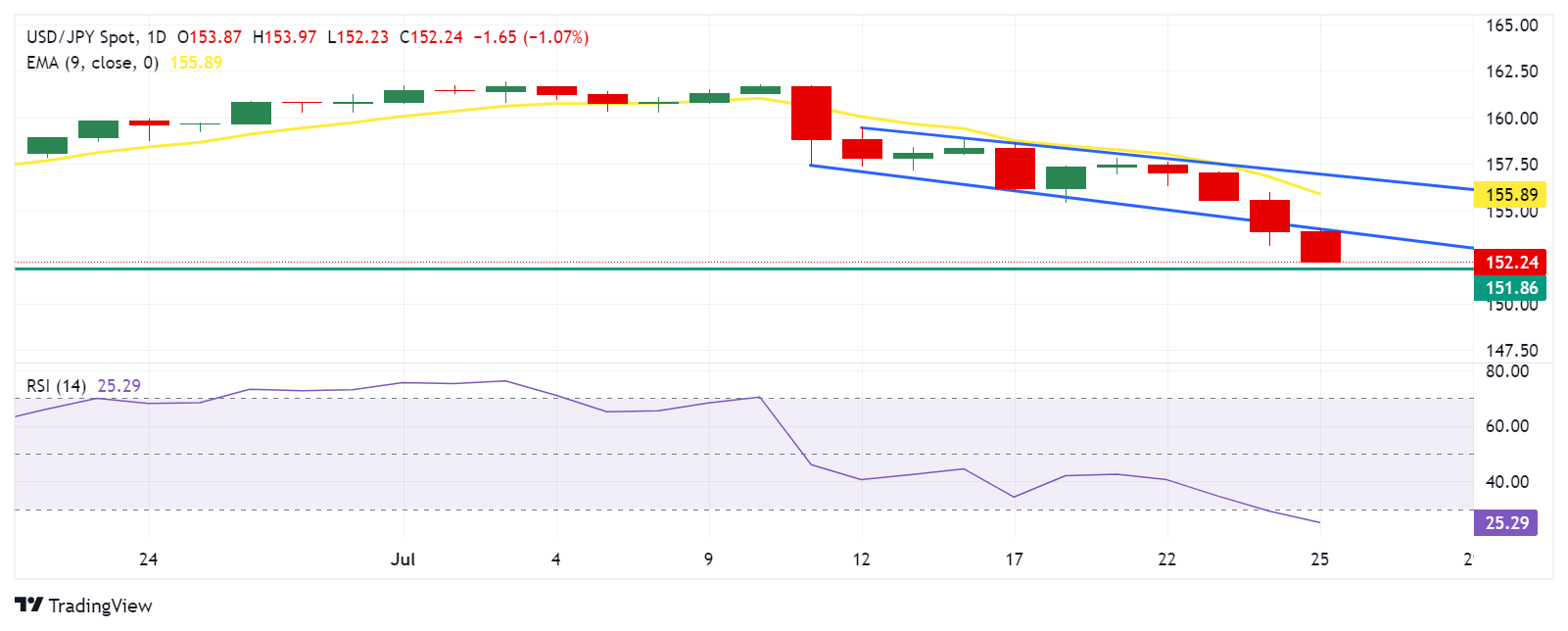Japanese Yen rises due to carry trades unwinding as BoJ policy meeting looms
- The Japanese Yen has reached its 12-week high of 152.64, as recorded on Thursday.
- Traders unwind their carry trades ahead of the BoJ policy meeting next week.
- The US Dollar may appreciate as recent US PMI data allows the Fed to maintain its restrictive policy.
The Japanese Yen (JPY) extends its upward trend against the US Dollar (USD) for the fourth straight session, hovering near its 12-week high of 152.64 set on Thursday. This strength in the Yen is likely due to traders unwinding carry trades ahead of the Bank of Japan’s (BoJ) policy meeting next week.
The Bank of Japan is expected to raise interest rates at the upcoming meeting next week, causing short-sellers to close their positions and bolstering the JPY. Additionally, the BoJ is widely anticipated to outline plans to taper its bond purchases to reduce massive monetary stimulus.
On Wednesday, Japanese Finance Minister Shunichi Suzuki and top currency diplomat Masato Kanda avoided commenting on foreign exchange matters, as the USD/JPY pair dropped to its lowest level in over two months, according to Reuters.
The US Dollar could gain ground as recent US PMI data revealed a faster expansion in private-sector activity for July, underscoring the resilience of US growth despite elevated interest rates. This data gives the Federal Reserve (Fed) more leeway to uphold its restrictive policy stance if inflation does not show signs of easing.
Investors are expected to closely monitor the US Gross Domestic Product (GDP) Annualized (Q2) data on Thursday and the Personal Consumption Expenditures (PCE) inflation data on Friday. These reports are expected to provide new insights into the economic conditions in the United States.
Daily Digest Market Movers: Japanese Yen appreciates due to increased risk aversion
- The Nikkei 225 Index dropped 2.5% to below 38,200, with Japanese shares hitting five-week lows as the decline in technology stocks intensified. This downturn followed disappointing quarterly results from US tech giants Tesla and Alphabet.
- The Japan Corporate Service Price Index (CSPI), which tracks the prices of services exchanged between companies, increased by 3.0% year-over-year in June, against the previous increase of 2.7%. This marks the fastest pace in over nine years, indicating rising inflationary pressures.
- The BlackRock Investment Institute noted in its mid-year outlook that Japan’s economic recovery and rising inflation make its equity market one of its strongest convictions. The firm anticipates that the Bank of Japan will not raise interest rates at next week's meeting.
- The S&P Global US Services PMI increased to a reading of 56.0 in July, the highest in 28 months, up from a 55.3 reading in June and exceeding market expectations of 55.3. Meanwhile, the Composite PMI rose to f 55.0 from the previous 54.8 reading, marking the highest reading since April 2022 and indicating sustained growth over the past 18 months.
- The Jibun Bank Japan Manufacturing PMI unexpectedly fell to 49.2 in July from 50.0 in the previous month, missing market forecasts of 50.5 and indicating the first decline in factory activity since April, according to preliminary estimates. In contrast, the Services PMI surged to 53.9 in July from a final reading of 49.4 in the prior month. This marks the sixth increase in the service sector this year and the steepest pace since April.
- Reuters reported on Monday that a senior official in the ruling party, Toshimitsu Motegi urged the Bank of Japan (BoJ) to more clearly communicate its plan to normalize monetary policy through gradual interest rate hikes, according to Reuters. Prime Minister Fumio Kishida added that normalizing the central bank’s monetary policy would support Japan's transition to a growth-driven economy.
- Media reports say that Vice President Kamala Harris has just passed 1,976 Democratic delegates to secure the party's presidential nomination. Harris is now the Democratic Party’s Presumptive Nominee for November’s Presidential Election.
- JP Morgan has anticipated no rate hike from the Bank of Japan (BoJ) in July or at any point in 2024. A July rate increase is not their base case, and they do not expect any hikes for the remainder of 2024. They believe it is too early to adopt a bullish stance on the Yen.
Technical Analysis: USD/JPY depreciates toward 152.00
USD/JPY trades around 152.30 on Thursday. The daily chart analysis shows that the USD/JPY pair has breached below the descending channel, indicating the strengthening of a dovish bias. Additionally, the 14-day Relative Strength Index (RSI) is below 30, indicating an oversold situation and a potential short-term rebound.
The USD/JPY pair may find significant support near at May's low of 151.86. Further support could be found at the psychological level of 151.00.
On the upside, the USD/JPY pair may test the lower boundary of the descending channel around the psychological level of 154.00. A return to the descending channel may weaken the bearish bias and support the pair to test the resistance at the nine-day EMA of 155.90, followed by the upper boundary of the descending channel around the level of 156.80.
USD/JPY: Daily Chart

Japanese Yen PRICE Today
The table below shows the percentage change of Japanese Yen (JPY) against listed major currencies today. Japanese Yen was the strongest against the Australian Dollar.
| USD | EUR | GBP | JPY | CAD | AUD | NZD | CHF | |
|---|---|---|---|---|---|---|---|---|
| USD | -0.02% | 0.10% | -0.93% | 0.04% | 0.42% | 0.19% | -0.23% | |
| EUR | 0.02% | 0.13% | -0.94% | 0.07% | 0.45% | 0.21% | -0.21% | |
| GBP | -0.10% | -0.13% | -1.04% | -0.07% | 0.33% | 0.07% | -0.34% | |
| JPY | 0.93% | 0.94% | 1.04% | 0.99% | 1.36% | 1.10% | 0.70% | |
| CAD | -0.04% | -0.07% | 0.07% | -0.99% | 0.39% | 0.15% | -0.28% | |
| AUD | -0.42% | -0.45% | -0.33% | -1.36% | -0.39% | -0.22% | -0.66% | |
| NZD | -0.19% | -0.21% | -0.07% | -1.10% | -0.15% | 0.22% | -0.43% | |
| CHF | 0.23% | 0.21% | 0.34% | -0.70% | 0.28% | 0.66% | 0.43% |
The heat map shows percentage changes of major currencies against each other. The base currency is picked from the left column, while the quote currency is picked from the top row. For example, if you pick the Japanese Yen from the left column and move along the horizontal line to the US Dollar, the percentage change displayed in the box will represent JPY (base)/USD (quote).
Japanese Yen FAQs
The Japanese Yen (JPY) is one of the world’s most traded currencies. Its value is broadly determined by the performance of the Japanese economy, but more specifically by the Bank of Japan’s policy, the differential between Japanese and US bond yields, or risk sentiment among traders, among other factors.
One of the Bank of Japan’s mandates is currency control, so its moves are key for the Yen. The BoJ has directly intervened in currency markets sometimes, generally to lower the value of the Yen, although it refrains from doing it often due to political concerns of its main trading partners. The current BoJ ultra-loose monetary policy, based on massive stimulus to the economy, has caused the Yen to depreciate against its main currency peers. This process has exacerbated more recently due to an increasing policy divergence between the Bank of Japan and other main central banks, which have opted to increase interest rates sharply to fight decades-high levels of inflation.
The BoJ’s stance of sticking to ultra-loose monetary policy has led to a widening policy divergence with other central banks, particularly with the US Federal Reserve. This supports a widening of the differential between the 10-year US and Japanese bonds, which favors the US Dollar against the Japanese Yen.
The Japanese Yen is often seen as a safe-haven investment. This means that in times of market stress, investors are more likely to put their money in the Japanese currency due to its supposed reliability and stability. Turbulent times are likely to strengthen the Yen’s value against other currencies seen as more risky to invest in.

